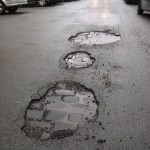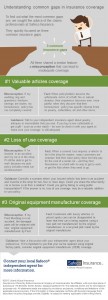Trusted Choice® survey shows about 50% of U.S. car owners report vehicle pothole damage. 
Poor road conditions have cost consumers and the insurance industry at least $27 billion over a five year period, according to a 2014 survey commissioned by Trusted Choice® and the Independent Insurance Agents & Brokers of America (IIABA or the Big “I”). The survey also reveals that from 2009 to 2014 half of car owners experienced damage to their vehicles as a result of potholes. As millions of Americans encounter potholes as the rough winter wraps, Trusted Choice® urges drivers to be cautious now and as repairs continue.
The snow, ice and freezing rain during the rough winter months left their mark on our roads in metro Atlanta and across the country. Severe potholes have led to accidents which may impact insurance rates, as premiums are determined by past claims, accidents and driving violations. Potholes and poor road conditions aren’t just an inconvenience, they are an expensive and dangerous result of harsh winters.
The pothole survey also found that 31% of car owners who reported pothole damage to their vehicles filed a claim with their insurance company. A surprising 65% of respondents who needed repairs said they (or a third party) paid out of pocket for the vehicle to be fixed. Only about 3% said local authorities stepped in to foot the bill. For about 40% of respondents, that bill was more than $500.
This survey highlights how widespread the pothole problem is on our roadways and that the costs are enormous to both the insurance industry and to consumers. And now, local authorities are struggling to keep up with the extensive road repairs.
While motorists in the Midwest, Northeast and North Central regions of the country reported the most pothole damage, surprisingly the numbers were not that different even in the Southern and Western regions which typically experience milder winters.
Trusted Choice® independent agents offer the following tips to motorists to help avoid costly damage from potholes and stay safe as they hit the roads after a tough winter:
Pothole safety tips:
- Keep an eye on traffic patterns. A number of cars that slows down or move quickly to other lanes may be a sign of major potholes or road damage ahead.
- Avoid the urge to swerve out of the way of a pothole at the last minute. You may swerve into the path of an oncoming vehicle. Risking damage to your car is wiser than risking the loss of your life or that of another person.
- Report potholes to your state or local transportation department. Some states and localities have pothole hotlines. Motorists who think their state or local government will pay for damage to their cars may be out of luck. Laws in this area vary by jurisdiction and, even where such remedies are available, conditions may apply such as a requirement that the jurisdiction had notice of the pothole.
- If you hit a pothole and suspect damage, pull over as soon as it is safe. If you notice damage, record details and specific damage—just as you would in the event of a collision with another motorist—in case you need to file an insurance claim.
- Check in at least annually with your independent insurance agent to ensure that you have the right coverage.
The pothole survey was conducted for Trusted Choice® and the Big “I” by MFour Mobile Research, Inc. using MFour’s Surveys on the Go® Smartphone Application Panel which includes Apple and Android mobile device users. MFour is an independent research company headquartered in Costa Mesa, California. Interviews of a nationally representative sample of 2,565 U.S. car owners were conducted in June 2014 and weighted by age and gender to represent the general U.S. population over age 18. More information about MFour can be obtained at www.mfour.com.








 Click to Call
Click to Call Get Directions
Get Directions
